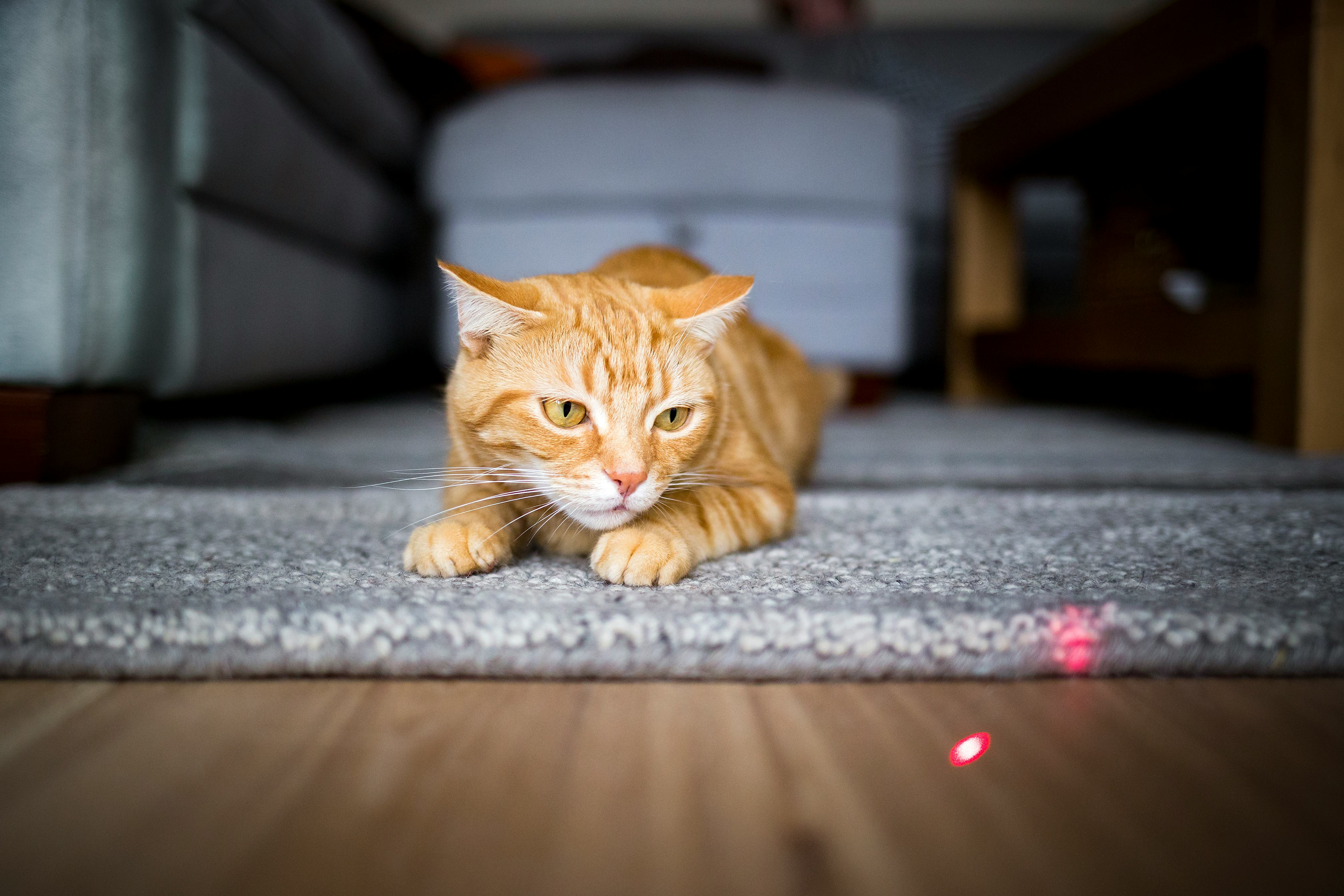
Laser pointers revolutionized the cat toy game. This compact tool, mere inches long, projects a captivating red dot across the room. Not bound by string or a plastic rod, this target easily pulls your cat across the floor and up the walls. This gadget has many spin-offs, including a collar that shoots a little red dot so your cat can keep himself entertained.
But considering that cats treat these light beams like material prey, they don’t get the same satisfaction that even chasing after a tinfoil ball offers. With this in mind, laser pointers go on trial: Are they actually good for your cat?
Are laser pointers good cat toys?
While laser pointers are great at occupying your cat’s attention and motivating him to exercise, they can be unfulfilling. You may have seen your cat stare in disbelief as he pounces squarely on the red dot, only for it to slide out of reach again.
“It’s like smelling your favorite food and never being able to eat it,” says Florencia Barrios-Fernández, a veterinary doctoral student and research assistant at the Universidad de la República in Montevideo, Uruguay.
As predators who get all their food from hunting in the wild, cats are hardwired to love stalking and catching prey. “Predatory behavior for cats is the best thing in the world,” Barrios tells Inverse. The act, she says, even releases feel-good endorphins in their brains. But hunting culminates in the catch and kill, while a laser is simply a ghost taunting your kitty.
This consistent disappointment can rile up anxiety and undesirable behaviors. Cats may engage in repetitive behaviors and chase other unattainable targets, like their own shadow or reflection. One study from 2022 in the Journal of Applied Animal Welfare Science shows a connection between frequent laser pointer play and repetitive behaviors like tail-chasing and staring at reflections.
While Barrios says it’s uncommon, lasers can also damage cat retinas when shined directly into the eye. However, this is more of an issue if you’re using a military-grade laser pointer; commercial laser pointers are safe — but still shouldn’t beam into anyone’s eye.
Why do cats like laser pointers?
While house cats are often associated with hunting rodents, Barrios says that they’ll hunt almost anything for protein, including bugs. She calls them bad hunters, saying they have about a 40 to 50 percent success rate, which is why they often spend much of the day hunting. A tiny red dot resembles a protein-rich bug, triggering your cat’s rapid movement behavior.
Barrios also points to a 2021 study that shows indoor house cats are more likely to engage in predatory-like play than indoor-outdoor cats. Compared to the latter, indoor cats showed a more intense reaction to artificial stimuli than to simulated prey. Your indoor cat is paying attention to all the potential prey that crosses its path, even if she never has to worry about food again. Promoting this predatory behavior is crucial to your cat’s well-being, Barrios continues. She says that 60 percent of sick cats stop playing, indicating that playtime cuts both ways. A sick cat may not want to play, but a cat that doesn’t play very often may be more likely to get sick.
How should I use a laser pointer with my cat?
Commercial laser pointers can be excellent cat toys with a few modifications. Barrios recommends that the laser pointer lead to tangible prey. “Use a laser pointer, then point it at a toy they like,” she says. For cats who are motivated by smell and taste (which might as well be all of them), a laser pointer could lead to a rubber toy stuffed with treats, though food isn’t necessary. “The reward might be the toy itself,” Barrios says.
She also advises sticking to open areas so your cat is less likely to crash into furniture. And, she’s not a fan of the laser-pointing collar. Since cats might run into something, she suggests that the owner always be in control of the moving red dot. That way, they can steer their kitty away from forbidden or dangerous furniture.
Still, visual stimulation isn’t necessarily bad. Barrios mentions research that shows 2D images can hold the attention of domestic cats living in shelters. Compared to cats who watched no television or program of inanimate objects, cats who watched an animated screen slept about 3 hours less.
You don’t have to throw out what might be your cat’s favorite toy. Just use it mindfully.







